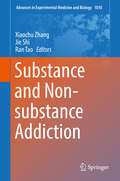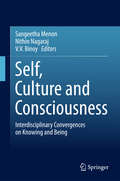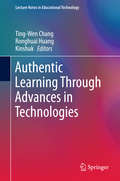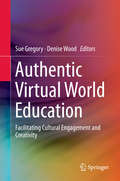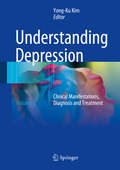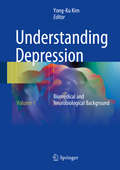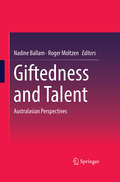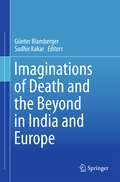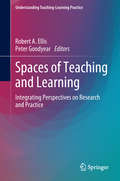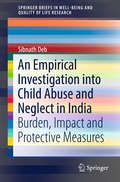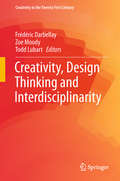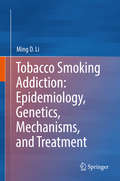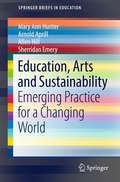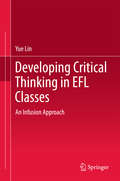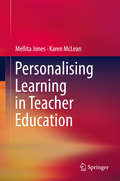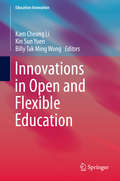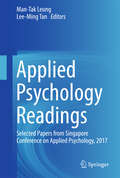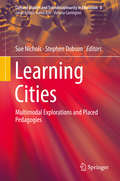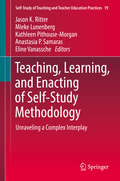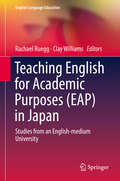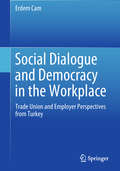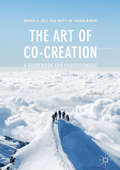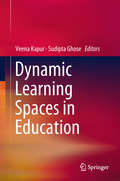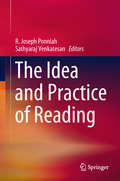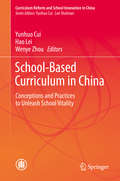- Table View
- List View
Substance and Non-substance Addiction
by Ran Tao Xiaochu Zhang Jie ShiThis book focuses on the similarities and differences between substance and non-substance addictions. It discusses in detail the mechanisms, diagnosis and treatment of substance and non-substance addictions, and addresses selected prospects that will shape future studies on addiction. Addiction is a global problem that costs millions of lives tremendous damage year after year. There are mainly two types of addition: substance addiction (e. g. , nicotine, alcohol, cannabis, heroin, stimulants, etc. ) and non-substance addiction (e. g. , gambling, computer gaming, Internet, etc. ). Based on existing evidence, both types of addiction produce negative impacts on individuals' physical, mental, social and financial well-being, and share certain common mechanisms, which involve a dysfunction of the neural reward system and specific gene transcription factors. However, there are also key differences between these two types of addiction. Covering these aspects systematically, the book will provide researchers and graduate students alike a better understanding of drug and behavioral addictions.
Self, Culture and Consciousness: Interdisciplinary Convergences On Knowing And Being
by Sangeetha Menon Nithin Nagaraj V. V. BinoyThis volume brings together the primary challenges for 21st century cognitive sciences and cultural neuroscience in responding to the nature of human identity, self, and evolution of life itself. Through chapters devoted to intricate but focused models, empirical findings, theories, and experiential data, the contributors reflect upon the most exciting possibilities, and debate upon the fundamental aspects of consciousness and self in the context of cultural, philosophical, and multidisciplinary divergences and convergences. Such an understanding and the ensuing insights lie in the cusp of philosophy, neurosciences, psychiatry, and medical humanities. In this volume, the editors and contributors explore the foundations of human thinking and being and discuss both evolutionary/cultural embeddedness, and the self-orientation, of consciousness, keeping in mind questions that bring in the interdisciplinary complexity of issues such as the emergence of consciousness, relation between healing and agency, models of altered self, how cognition impacts the social self, experiential primacy as the hallmark of consciousness, and alternate epistemologies to understand these interdisciplinary puzzles.
Authentic Learning Through Advances in Technologies (Lecture Notes in Educational Technology)
by Kinshuk Ronghuai Huang Ting-Wen ChangThis book introduces the advanced technologies used for authentic learning, an educational term that refers to a variety of techniques focusing on how students apply the skills and knowledge acquired in school in real-world situations. In the meanwhile, it presents the latest trends and future developments in learning design, learning environment and assessment for authentic learning using advances in technology, this book discusses how technology supports authentic learning and what makes it effective.
Authentic Virtual World Education: Facilitating Cultural Engagement and Creativity
by Sue Gregory Denise WoodThe book presents the possibilities and realities of virtual worlds in education through the application of 3D virtual worlds to support authentic learning, creativity, learner engagement and cultural diversity in higher education. It includes a unique variety of cross disciplinary approaches to research, teaching and learning in a virtual world, including analysis of data from the experiences of students in education, law, Chinese language, sustainability, computer architecture, business, health and the Arts. The book provides unique learning experiences that have celebrated the rich media of virtual world environments through the utilisation of affordances such as simulation, bots, synchronous interaction, machinima and games. The perspectives come from Australia and New Zealand higher education academics but transferable to any higher educational institution in the sector, worldwide, and is significant to various disciplines in the higher education field.
Understanding Depression: Volume 1. Biomedical And Neurobiological Issues
by Yong-Ku KimThis book, in two volumes, focuses on contemporary issues and dilemmas in relation to depression. The aim is to equip readers with an up-to-date understanding of the clinical and neurobiological underpinnings of depression and their relation to clinical manifestations and the development of more effective treatments. This first volume is devoted specifically to biomedical and neurobiological issues. Detailed information is presented on a wide range of topics, including genetics, molecular and cellular biology, and aspects at the neural circuit and multicellular system levels. Readers will gain a deeper appreciation of the factors and interactions underlying individual variation in responsiveness to stress and vulnerability to depression, as well as a clear understanding of potential treatment targets and causes of treatment resistance based on the latest research. A concluding section considers progress towards precision psychiatry and gender and cultural differences in depression. The companion volume is dedicated to clinical and management issues in depression. Understanding Depression will be an excellent source of information for both researchers and practitioners in the field.
Understanding Depression: Volume 1. Biomedical And Neurobiological Issues
by Yong-Ku KimThis book, in two volumes, focuses on contemporary issues and dilemmas in relation to depression. The aim is to equip readers with an up-to-date understanding of the clinical and neurobiological underpinnings of depression and their relation to clinical manifestations and the development of more effective treatments. This first volume is devoted specifically to biomedical and neurobiological issues. Detailed information is presented on a wide range of topics, including genetics, molecular and cellular biology, and aspects at the neural circuit and multicellular system levels. Readers will gain a deeper appreciation of the factors and interactions underlying individual variation in responsiveness to stress and vulnerability to depression, as well as a clear understanding of potential treatment targets and causes of treatment resistance based on the latest research. A concluding section considers progress towards precision psychiatry and gender and cultural differences in depression. The companion volume is dedicated to clinical and management issues in depression. Understanding Depression will be an excellent source of information for both researchers and practitioners in the field.
Giftedness and Talent
by Nadine Ballam Roger MoltzenThis book brings together recent postgraduate research in the broad area of giftedness, talent development and gifted education conducted across New Zealand and Australia. It addresses the significant demand for research in the field undertaken outside the United States and offers valuable practical insights. Divided into 14 chapters, the book explores giftedness and talent in a diverse range of socioeconomic cohorts and contexts, including examinations of gender, race and ethnicity. Though primarily intended for practitioners, it will also benefit undergraduate and postgraduate students, researchers and educators in New Zealand, Australia and beyond.
Imaginations of Death and the Beyond in India and Europe
by Günter Blamberger Sudhir KakarThis volume explores current images of afterlife/afterdeath and the presence of the dead in the imaginations of the living in Indian and European traditions. Specifically, it focuses on the deepest and most fundamental uncertainty of human existence---the awareness of human mortality, on which depends any assignment of meaning to earthly existence as also to notions of worldly and otherworldly salvation. This central idea is addressed in the literature, arts, audiovisual media and other cultural artefacts of the two traditions. The chapters are based on two main assumptions: First, that one cannot report on the direct experience of death; so it is only possible to speak allegorically of it. Second, in contemporary Western societies, marked by structural atheism, people look at literature, the arts and mass media to study their depiction and reading of traditionally religious questions of disease, death and the Beyond. This is in contrast to Asian civilizations whose preoccupation with death and Beyond is persistent and perhaps central to the civilizations’ highest thought. The chapters cover a wide spectrum of disciplinary approaches, from psychoanalysis to religious, anthropological, literary and film studies, from sociology and philosophy to art history, and address issues of unsettling power: comforting illusions of afterlife; the relations between afterlife and fertility; visions of technological immortalization of mankind; the problem of thinking about death after the “death of God”; socialist utopias of bodily immortality; fear of Hell and punishment; different concepts in relating the living and the dead; near-death experiences; and cultural practices of spiritualism, occultism and suicide.
Spaces of Teaching and Learning
by Robert A. Ellis Peter GoodyearThis integrated collection of perspectives on the spaces of teaching and learning uses ‘learning space’ to place educational practice in context. It considers the complex relationships involved in the design, management and use of contemporary learning spaces. It sheds light on some of the problems of connecting the characteristics of spaces to the practices and outcomes of teaching and learning. The contributions show how research into learning spaces can inform broader educational practices and how the practices of teaching, learning and design can inform research. The selection of chapters demonstrates the value of gathering together multiple sources of evidence, viewed through different epistemological lenses in order to push the field forward in a timely fashion. The book provides both a broad review of current practices as well as a deep-dive into particular educational and epistemological challenges that the various approaches adopted entail. Contrasts and commonalities between the different approaches emphasise the importance of developing a broad, robust evidence-base for practice in context. This is the inaugural book in the series Understanding Teaching-Learning Practice.
An Empirical Investigation into Child Abuse and Neglect in India: Burden, Impact And Protective Measures (SpringerBriefs in Well-Being and Quality of Life Research)
by Sibnath DebThis book provides a comprehensive overview of child abuse and neglect globally in general terms and with empirical evidence from Puducherry, India. The study unearths the reality concerning child safety and raises a number of questions about child safety measures at the institutional and family levels. It recommends evidence-based and culture-specific preventive measures for child protection. The empirical evidence presented here provides important and useful information to school administrators on the issues of child abuse and neglect, for them to take evidence-based protective measures both at school and at home. For cross-cultural comparison, the findings are of interest to international scholars and academics. This work is useful for policy makers, educators, NGO personnel, child rights activists and opinion leaders in government departments dealing with children, and for researchers in the fields of psychology, social work, nursing, pediatric, forensic medicine, and public health.
Creativity, Design Thinking and Interdisciplinarity (Creativity in the Twenty First Century)
by Frédéric Darbellay Zoe Moody Todd LubartThis book, at the crossroads of creativity, design and interdisciplinary studies, offers an overview of these major trends in scientific research, society, culture and economics. It brings together different approaches and communities around a common reflection on interdisciplinary creative design thinking. This collective effort provides a unique dialogical and convergent space that deals with the challenges and opportunities met by researchers and practitioners working on design thinking, creativity and inter- and transdisciplinarity, or at the interface between these areas.
Tobacco Smoking Addiction: Epidemiology, Genetics, Mechanisms, and Treatment
by Ming D. LiThis book provides the most recent knowledge on almost all key aspects of the health impact of tobacco smoking. Its 21 chapters focus on both preclinical and clinical studies. The contents are broad, covering the epidemiology of tobacco smoking; genetic epidemiology; identification of susceptibility genomic regions, genes, and pathways as determined by both human and animal studies; evolutionary relations among the different nAChR subunit genes that are so important to the nicotine response; smoking-related diseases; E-cigarettes; and smoking cessation. Furthermore, each chapter includes a detailed and comprehensive list of key references. For both clinical and basic researchers, this book is a valuable resource on nicotine dependence and other addictions.
Education, Arts and Sustainability: Emerging Practice For A Changing World (SpringerBriefs in Education)
by Mary Ann Hunter Arnold Aprill Allen Hill Sherridan EmeryThis book addresses this challenge by proposing an integration of sustainability and arts education in both principle and practice. In a global context of intensifying social, economic and environmental crises, education is key to raising awareness and motivating individuals and communities to act in sustaining life in our more-than-human world. But how is this done when the complexity and need for change becomes overwhelming, and schooling systems become complicit in supporting the status quo?Drawing on critical education theory and precepts of creativity, curiosity and change, it documents a series of case examples that demonstrate how five principles of Education for Sustainability - critical thinking, systems thinking, community partnership, participation, and envisioning better futures - are found at the heart of much arts practice in schools. Featuring the creative work and voices of teachers working in arts-based enquiry and diverse community-engaged contexts, the book investigates how sustainability principles are embedded in contemporary arts education thinking and pedagogy. The authors are unapologetically optimistic in forming an alliance of arts and sustainability education as a creative response to the challenge of our times, arguing that while they may have operated on the margins of conventional pedagogy and curriculum, they have more than marginal impact.
Developing Critical Thinking in EFL Classes: An Infusion Approach
by Yue LinThis book presents an innovative teaching experiment and an analytical study of critical thinking and the sociocultural theory of learning to illustrate the cognitive learning development mechanisms. It addresses the issues in developing critical thinking, including the controversy surrounding the definition, measurement and teaching of critical thinking, particularly in the L2 context.The book explains how infusion-thinking lessons can be structured to help students develop critical thinking along with language learning. Further, it uses a case study as a real-world example to examine the applicability and feasibility of infusion-thinking lessons in the EFL context and their effectiveness in developing students’ critical thinking and language learning.Packed with thinking activities and techniques, this practical, hands-on manual provides original ideas and empirical data, giving teachers everything they need to plan their lessons to improve students’ critical thinking within language courses and evaluate their teaching.
Personalising Learning in Teacher Education
by Mellita Jones Karen McLeanThis volume sheds light on debates about personalised learning in teacher education by exploring the popular emergence of personalising learning in education and hence its significance in teacher education in the 21st century. It examines personalising learning theory and explores the tenets of this theory and its recent trends in international settings. The theory is explored in relation to both general and higher education pedagogy, and in a range of examples within a teacher education context. The examples from practice provide insights into maximising the potential for personalising learning theory to enhance teaching, learning and assessment in teacher education. The book includes case studies involving pre-service teachers working in communities of practice with one another, with schools and with the wider community. Examples of technology for personalising learning are also described. All the case studies demonstrate how the learner is made central to the teaching and assessment approaches adopted and contributes to a lifelong learning continuum. Providing insights into a new pedagogy for teacher education that leads to an enriched student experience, the book presents a model for personalising learning in teacher education that offers support for 21st century teacher educators.
Innovations in Open and Flexible Education (Education Innovation Series)
by Kam Cheong Li Kin Sun Yuen Billy Tak WongThis book covers a broad range of innovations in education, such as flipped classrooms, the educational use of social media, mobile learning, educational resources and massive open online courses, as well as theoretical discussions and practical applications in the use of augmented reality and educational technology to improve student engagement and pave the way for students’ future studies and careers. The case studies and practical applications presented here illustrate the effectiveness of new modes of education in which the latest technologies and innovations are widely used in the global context. Accordingly, the book can help develop readers’ awareness of the potential these innovations hold, thus expanding their expertise and stimulating critical thinking as to how new technologies have made learning and teaching easier in various educational settings.
Applied Psychology Readings: Selected Papers From Singapore Conference On Applied Psychology 2016
by Man-Tak Leung Lee-Ming TanThis book is a compilation of the best papers presented at the 2017 edition of the Singapore Conference of Applied Psychology (SCAP), an event held annually in Singapore. Discussing the latest innovations, trends, concerns, practical challenges encountered and the solutions adopted in the field of applied psychology, it is a valuable resource for academics, researchers and practitioners wishing to keep themselves up to date with the state of the art in the field.
Learning Cities: Multimodal Explorations And Placed Pedagogies (Cultural Studies and Transdisciplinarity in Education #8)
by Stephen Dobson Sue NicholsThis book is an interdisciplinary text exploring the learning and educative potentials of cities and their spaces, including urban and suburban contexts, at all stages of life. Drawing on the insights of researchers from diverse fields, such as education, architecture, history, visual sociology, applied linguistics and sensory studies, this collection of papers develops and demonstrates the connection between experience, in all its dimensions, and informal learning in the city. The chapters discuss various sensory domains of experience, considering visual, embodied, and even sexual dimensions in relation to what and how learning operates, and the contributors reflect on their learning and inquiring experiences in the city, with special reference to topics such as narrativity, ‘race’ and ethnicity, equity, urban literacy, re-generation, participation, representation and oral histories.
Teaching, Learning, and Enacting of Self-Study Methodology: Unraveling A Complex Interplay (Self-study Of Teaching And Teacher Education Practices Ser. #19)
by Jason K. Ritter Mieke Lunenberg Kathleen Pithouse-Morgan Anastasia P. Samaras Eline VanasscheThis book offers a collection of original, peer-reviewed studies by scholars working to develop a knowledge base of teaching and facilitating self-study research methodology. Further, it details and interconnects perspectives and experiences of new self-study researchers and their facilitators, in self-study communities in different countries and across different continents. Offering a broad range of perspectives and contexts, it opens up possibilities for encouraging the collaborative and continuous growth of teaching and facilitating self-study research within and beyond the field of teacher education. The breadth of the scholarship presented expands scholarly discussions concerning designing, representing, and theorising self-study research in response to pressing educational and social questions. By documenting and understanding what teaching and learning self-study looks like in different contexts and what factors might influence its enactment, the book contributes to building a kaleidoscopic knowledge base of self-study research. Overall, this book demonstrates the impact on participants' professional learning and validates the authenticity and generative professional applications of self-study methodology for and beyond teacher education, providing implications and recommendations for practitioners on a global level.
Teaching English for Academic Purposes: Studies From An English-medium University (English Language Education #14)
by Rachael Ruegg Clay WilliamsThis book focuses on appropriate English for Academic Purposes instructional concepts and methods in the Japanese context. It investigates a variety of pedagogical techniques, addressing the fundamental academic English skills – listening, speaking, reading and writing – as well as assessment and materials development. All the research included was conducted in Japanese university settings, thus shedding new light on the effective implementation of EAP teaching and learning activities with Japanese learners of English. This book is of interest to anyone working in an EAP context at the secondary or tertiary level, especially those which include Japanese learners.
Social Dialogue and Democracy in the Workplace: Trade Union and Employer Perspectives from Turkey
by Erdem CamThis book focuses on the experience of social dialogue in Turkey, which is a European Union candidate country. It argues that social dialogue constitutes one of the fundamental pillars of European social model and therefore should be analysed not only at the supranational level but also at the national, sectoral and workplace levels. The book critically examines social dialogue processes and mechanisms in Turkey at various levels, with focus on the workplace because it is shaped by socio-cultural elements which contain many variables. The book also identifies the shortcomings and structural impediments of social dialogue, and provides an empirically grounded theoretical explanation of social dialogue in Turkey. In the process, the book explains and clarifies key concepts to help readers grasp important points relevant to social dialogue, and contains interviews with social partners to take into consideration their views and recommendations on social dialogue. These in-depth interviews also provide a rare insight into the dynamics of social dialogue on the ground. By looking at social dialogue at various levels, the book offers a balanced view of its strengths and weaknesses in Turkey. This book is a valuable tool for students, academics and researchers interested in understanding the complex dynamics of social dialogue and workplace relations in Turkey.
The Art of Co-Creation: A Guidebook For Practitioners
by Bryan R. Rill Matti M. HämäläinenThis book illustrates how to design and implement co-creation, a powerful form of collective creativity that harnesses the potential of teams and can generate breakthrough insights. Skilled leaders and facilitators can utilize this approach to unleash the creative potential of their organizations. Drawing from years of applied research, the authors bring together insights from the fields of design and organizational development into an evocative and pragmatic “how-to” guidebook. Taking a human-centred rather than process oriented perspective, the book argues that experience design separates true co-creation from other forms of collective efforts and design thinking. Collective moments of creative insight emerge from the space between, an experience of flow and synchronicity from which new ideas spring forth. How to create and hold this space is the secret to the art of co-creation. Collective breakthroughs require stakeholders to undergo a journey from the world of their existing expertise into spaces of new potential. It requires leaders moving from a position of dominating space to holding the space for others, and developing core capacities such as empathy and awareness so that teams can engage each other co-creatively. This book uncovers the secrets of this journey, enabling process designers to develop more effective programs.
Dynamic Learning Spaces in Education
by Veena Kapur Sudipta GhoseThis volume discusses the need for a major paradigm shift in educational practice in the current digital and globalized world. It establishes a bridge between theory and praxis and revisits the objectives of learning and its modalities within the context of a rapidly evolving global world order. This volume includes perspectives from different countries on creating a dynamic and adaptive education system that encourages creativity, leadership, flexibility, and working in virtual as well as inclusive environments. The four sections include chapters that discuss creating meaningful learning environments, preparing teachers for new age classrooms, the digital learning space, fostering change in classrooms, and importantly also includes cases and experiments from schools. The authors are teacher educators, teachers and researchers, and each chapter, while being deeply rooted in theory, is juxtaposed with informed practice, making the suggestions easy to implement in different settings. This is an important resource for researchers and practitioners associated with education systems in creating engaging, meaningful and future-ready education practices.
The Idea and Practice of Reading
by Sathyaraj Venkatesan R. Joseph PonniahThis book addresses basic issues in language education and explores how reading, with a focus on meaning, contributes to the development of all aspects of language including vocabulary, spelling, grammar, and syntax. It departs from traditional methods and practices in language learning to investigate the potency of reading in improving language acquisition. The traditional practice in language classes to teach language skills explicitly through acquiring forms and structures of language is often less than successful, and teachers are gradually incorporating reading materials and practices into the curriculum. This book provides important inputs to language teachers and educators on the need to include reading as an idea and as a practice into the curriculum. Among other things, it explores the benefits of incidental learning of language properties such as vocabulary, syntax and grammar and gives adequate exposure to different types of reading strategies to promote reading among learners. It also exploits the possible transfer of L1 reading strategies and capabilities to L2 reading for language acquisition. In so doing, this book hopes to promote autonomous learning among L2 learners and guide readers in alternative strategies to solve comprehension problems.
School-Based Curriculum in China: Conceptions and Practices to Unleash School Vitality (Curriculum Reform and School Innovation in China)
by Yunhuo Cui Hao Lei Wenye ZhouThis book first develops a framework to understand the curriculum administration system in China. It describes the historical process of localizing school-based curricula as well as the significance and positioning of school-based curricula, and presents in detail cases of how three types of school-based curriculum were developed and implemented in Chinese schools.The book outlines for the first time best practices in school-based curriculum development in China, i.e. how to make a holistic curriculum plan, how to design a curriculum, and how to develop a course in the context of a school-based curriculum. By discussing these three aspects, it clearly summarizes the strategies and technologies for school-based curriculum development, which are applicable across contexts.Although the concept originated outside China, school-based curriculum development in China differs from that in other countries both in theory and practice. This book equips readers with theoretical and practical knowledge of how to develop school-based curricula and how to generate experiences for new curriculum development.This timely book is a valuable resource for researchers, curriculum designers, school teachers and others who are interested in school-based curriculum development.
